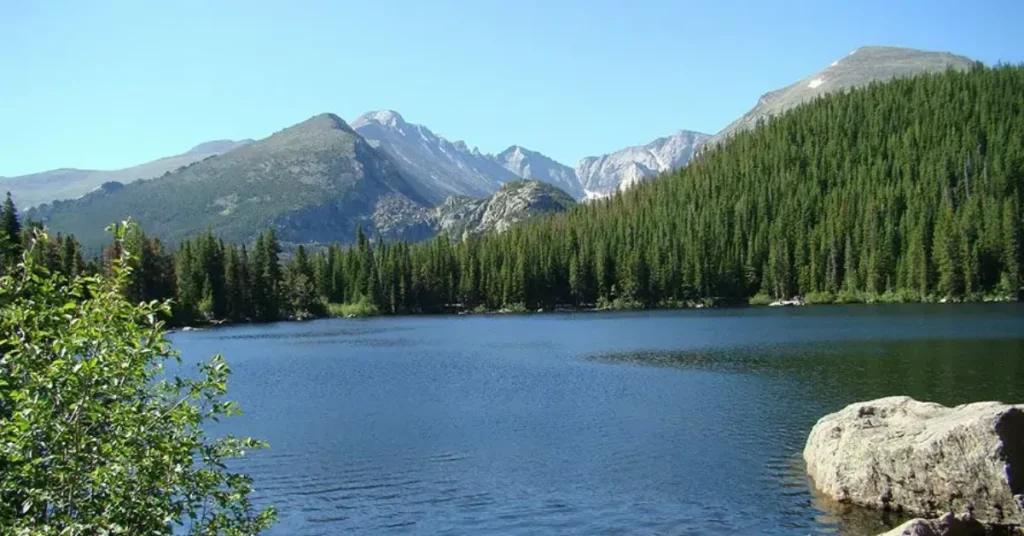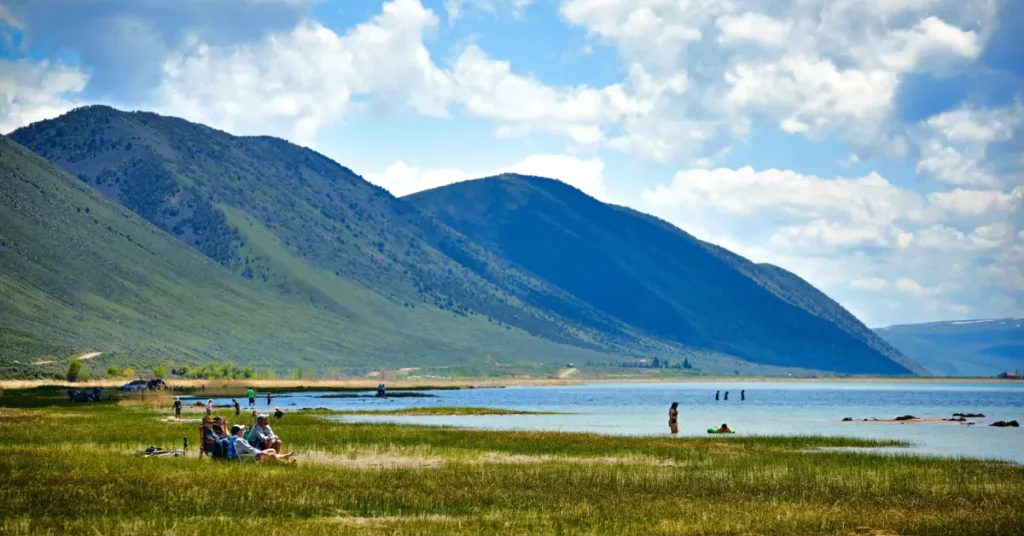Bear Lake has a maximum depth of 208 feet (63 meters). It is located on the Utah-Idaho border in the United States.
Nestled in the embrace of rugged mountains, Bear Lake is a freshwater haven known for its vibrant turquoise-blue water, earning it the nickname “Caribbean of the Rockies.”
This natural reservoir stretches over 20 miles long and 8 miles wide, covering a significant area that lures visitors with its beauty and recreational activities.
As an alpine lake, Bear Lake captivates fishermen, boaters, and nature enthusiasts alike, offering an idyllic destination for those seeking adventure or a tranquil retreat.
The lake’s considerable depth contributes to its unique coloration and diverse ecosystem, making it an intriguing subject for both scientists and tourists.
With a blend of natural splendor and depth, Bear Lake stands as a gem in the mountainous landscape, drawing countless visitors each year.

Bear Lake’s Depths: A Hidden World
Imagine plunging into a hidden world beneath the surface of Bear Lake. This natural wonder, nestled at the border of Utah and Idaho, boasts depths that few know about.
What mysteries lie beneath its gleaming blue waves? Let’s dive in and explore Bear Lake’s enigmatic depths.
Unmasking The Deepest Points
The true essence of Bear Lake comes alive when we look towards its deepest enclaves. Curious minds might wonder, “Just how deep does this lake go?”
Bear Lake astonishes with its most profound point reaching approximately 208 feet. That’s like stacking nearly 20 school buses from end to end!
Comparing Depth With Other Notable Lakes
In a world brimming with vast lakes, how does Bear Lake stand? Let’s compare:
| Lake Name | Maximum Depth (feet) |
| Bear Lake | 208 |
| Lake Tahoe | 1,645 |
| Crater Lake | 1,949 |
Side by side with giants like Lake Tahoe and Crater Lake, Bear Lake might seem less deep. Yet, it remains remarkable in its right, harboring a unique ecosystem and drawing visitors with its tranquil beauty.
Geological Secrets Beneath The Surface

Bear Lake, with its mesmerizing turquoise waters, is not just a feast for the eyes. It holds secrets beneath its shimmering surface that tell tales of ancient geological activities.
Scientists and nature enthusiasts are captivated by the mysteries this natural wonder conceals. Let’s dive into Bear Lake’s depths and unearth the geological features that lie hidden from sight.
Formation Of Bear Lake’s Basin
Bear Lake was born out of dramatic earth-moving forces. The lake’s basin is a result of faulting, a geological process where the earth’s crust cracks and shifts.
This action created a deep trough that was later filled with water. The surrounding mountains fed the basin with sediments, further shaping the lakebed.
- Earth’s crust movement led to the current basin.
- Sediment from mountains altered the lakebed.
Submerged Features And Anomalies
Bear Lake’s floor is a landscape of valleys and peaks. It’s a submerged mirror of the rocky terrain that surrounds it.
| Feature: | Description: |
| Underwater Hills | Small elevations found across the lake. |
| Depressions | Sunken areas likely from past geological events. |
Audiences are captivated by these secrets. Each feature tells a part of Bear Lake’s story. With advanced technology, we might decipher more of these underwater mysteries.
The depth and intrigue of Bear Lake continue to beckon adventurers and scientists alike to explore its enigmatic depths.
Ecological Wonders At Various Depths
Bear Lake, often hailed as the Caribbean of the Rockies, fascinates with its vibrant blue hues.
Yet, beneath its alluring surface, the lake’s depths harbor ecological secrets awaiting discovery. Bear Lake’s ecosystem varies with depth, presenting distinct zones where life adapts uniquely to survive in the aquatic wilderness.
Life In The Twilight Zone
The ‘twilight zone,’ or mesopelagic layer, begins where sunlight starts to wane. Despite the dim light, an array of creatures thrives here.
- Plankton – Microscopic life that serves as a food base.
- Small fish – Navigate the shadows, escaping predators from above.
- Insects – Such as Caddisflies and Water Beetles, exploit niches in this dim area.
Adaptations To The Deep Lake Environment
Creatures dwelling in Bear Lake’s deeper waters showcase fascinating adaptations. They survive in conditions far from the sunny shallows.
| Species | Adaptation |
| Deepwater Sculpin | Increased sensory capabilities for low-light hunting. |
| Blind Amphipods | No eyes needed in the perpetual dark. |
| Slender Naiads | Plants that filter feed, anchoring to soft lakebeds. |
These adaptations, from heightened senses to the absence of eyes, indicate a delicate balance.
Life in Bear Lake’s deep realm is a captivating dance of survival. Exploring these ecological wonders at various depths offers insights into the resilience and complexity of life below the surface.
Human Exploration And Measurement
Bear Lake sparkles as a natural gem straddling the Utah-Idaho border. Its brilliant blue waters have beckoned humans to explore its depths for years.
This section delves into how we’ve measured the lake’s true depth through human exploration and innovative technology.
Historical Efforts To Gauge The Depth
Long before modern equipment, early settlers were curious about Bear Lake’s depth. Tales of the lake being bottomless abounded.
Adventurous souls used simple rope lines with weights to probe the waters. They discovered that Bear Lake was far deeper than anyone had initially thought.
- 1800s settlers used weighted lines.
- Anecdotal records suggest varied depth.
- Initial explorations proved the lake’s significant depth.
Technological Advancements In Depth Mapping
Technology revolutionized our understanding of Bear Lake. Sonar technology gave us precise readings of lakebed contours. Civilian and scientific groups have since mapped the entire lake.
Modern efforts include:
| Year | Technology | Depth Findings |
| 1980s | Sonar | Recorded depths over 200 feet |
| 2000s | Digital mapping | Enhanced depth accuracy |
| Recent | 3D imaging | Detailed underwater features |
Remote sensing and GPS have played vital roles. These technologies have uncovered deep trenches. We now know Bear Lake reaches depths of approximately 208 feet.
Current studies aid in:
- Wildlife conservation.
- Natural resource management.
- Educational and recreational uses.
The Cultural And Mythical Significance
Bear Lake stretches deep into the Earth, its waters shrouded in enigma. This mystic body of water is not just a natural wonder.
It holds a special place in the hearts of locals and visitors. Stories as deep as the lake itself have passed down through generations. These tales shape the culture around this fascinating expanse of water.
Legends And Folklore Of Bear Lake’s Depths
Folk tales tell of curious creatures lurking beneath the waves of Bear Lake. The most famous is the “Bear Lake Monster.” This mythical beast resembles a serpent and captures the imagination of many. Legends say it dwells in the deepest parts of the lake.
Another tale speaks of a submerged ancient city. It lies hidden far below the lake’s surface. Treasure hunters and curious folks alike dream of one day discovering its riches. Such stories add an air of mystery and adventure to Bear Lake’s deep waters.
Influence On Local Communities And Tourism
Local communities have embraced these tales. They have become a part of their heritage. The stories draw tourists from all over. People come to experience the mystique first-hand.
Cultural events are inspired by these myths. The Bear Lake Monster Winterfest and Bear Lake Monster Swim are notable examples. They turn the legends into real experiences for visitors.
Stores and businesses also reflect the lake’s mythical status. They carry names and symbols honoring the legends. Visitors find Bear Lake more than just a destination. They find it a treasure trove of stories and folklore.
Conservation And The Future Of Bear Lake

Bear Lake is a natural wonder, cherished for its beauty and depth. Conservation efforts are vital for sustaining this majestic lake for future generations.
Understanding its depth sparks interest in both its ecological importance and its vulnerability to environmental changes. Let’s delve into how we can safeguard the future of Bear Lake.
Protecting The Lake’s Delicate Ecosystems
Protection of Bear Lake’s ecosystems is critical.
- Preserving water quality is essential to support wildlife.
- Native species depend on clean, deep waters to thrive.
- Integrated management plans help prevent pollution and overfishing
Active efforts include constant monitoring and environmental education to engage the community. These help maintain the lake’s vibrant habitat.
Impact Of Climate Change On Lake Depth
Climate change poses a threat to Bear Lake’s depth and health.
- Rising temperatures can lead to increased evaporation rates.
- Altered precipitation patterns may affect water levels.
- Monitoring lake depth gives clues about climate impacts.
Ongoing research and adaptive strategies are crucial for mitigating these effects. Collaborative actions aim to preserve Bear Lake’s natural state despite climate challenges.
FAQs About How Deep Is Bear Lake
What Is The Depth Of Bear Lake?
Bear Lake reaches depths of around 208 feet at its deepest point. It is known for its vibrant blue waters and natural beauty. This depth contributes to its unique ecosystem and recreational popularity.
Why Is Bear Lake So Deep?
Glacial activity carved Bear Lake’s basin, leading to its impressive depth. Subsequent geological activity and natural sedimentation have preserved its depth. This glacial history defines Bear Lake’s deep characteristics.
How Does Bear Lake’s Depth Compare To Others?
Compared to many other natural lakes, Bear Lake is quite deep. Its maximum depth of 208 feet stands out, especially in the Rocky Mountain region. It is deeper than nearby lakes of similar size.
Can You Dive In Bear Lake?
Yes, scuba diving is possible in Bear Lake due to its clarity and depth. Divers can explore underwater features and the lake’s unique marine life. Always dive with proper equipment and guidance.
Conclusion
Bear Lake’s depths hold many secrets, reaching up to 208 feet in some places. Understanding this vast body of water enhances any visitor’s awe.
Whether you’re exploring its corners for leisure or study, its vastness promises a memorable adventure. Dive into Bear Lake’s wonders and cherish its natural splendor every time.
Resources:
1. https://parksandrecreation.idaho.gov/parks/bear-lake/
